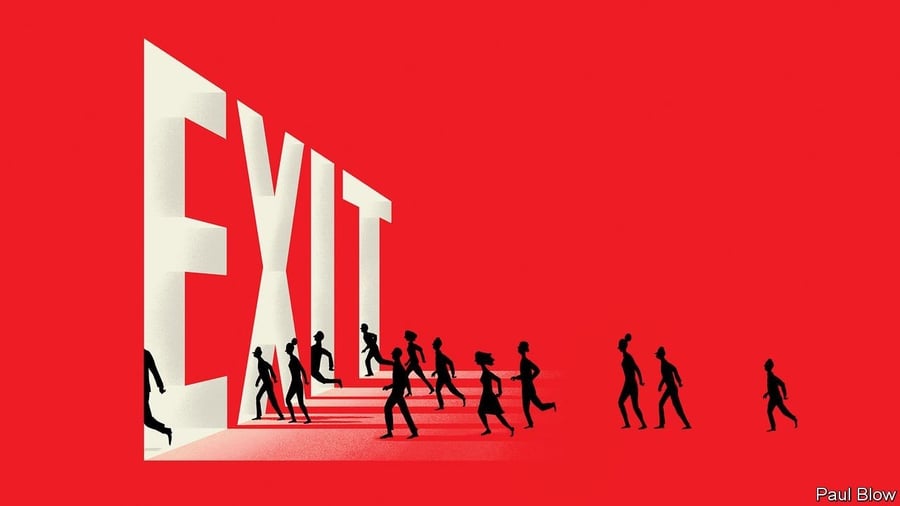How “The Great Resignation” Will Affect Businesses in 2022

It is incredibly hard to envision just how historic “The Great Resignation” has been with a record number of American workers voluntarily quitting their jobs month after month.
Consider this: the U.S. Bureau of Labor Statistics has been tracking the number of U.S. workers who quit their jobs each month, and prior to last year, the record for quits in a single month was 3.6 million in July 2019.
Last year, nearly 4 million U.S. workers quit their jobs in April and the number of quits stayed above that 3.6 million high-water mark for each of the next eight months.
And “The Great Resignation” entered 2022 showing no signs of slowing down with the quits number averaging a staggering 4.4 million workers per month over the final four months of the year, including an all-time new record of 4.5 million in November.
“The Great Resignation has continued to dominate headlines and stun business leaders as turnovers reach new highs,” reported CNBC in mid-January.
The Great Resignation: Get Ready for Round 2
The Great Resignation may not be abating anytime soon, according to Will Johnson, CEO of The Harris Poll.
Johnson told AdAge that: “Nearly 1 in 4 Americans (23 percent) told us in early December that they plan to quit their jobs within a year. Most prospective resignees – a whopping 70 percent – planned to give notice before the end of the month.”
Young workers were most likely to join the next round of The Great Resignation with those ages 18 to 34 saying they were twice as likely as older workers (34 percent vs. 15 percent) to leave their job in the coming year.
“Not surprisingly, younger workers, who are less entrenched in their careers and are less likely to have financial ties such as mortgages and children, were twice as likely than their older colleagues to be planning to walk out,” wrote Johnson.
The poll also asked American workers what they want and three items were high on that list:
- 32 percent want better working conditions
- 30 percent said they felt burned out at work
- 29 percent want better big paychecks
Texas A&M organizational psychologist and professor Anthony Klotz, who coined The Great Resignation phrase in an interview with Bloomberg last May, agreed that this unique labor movement would continue into 2022.
“It’s not just about getting another job, or leaving the workforce, it’s about taking control of your work and personal life, and making a big decision – resigning – to accomplish that,” Klotz told CNBC Make It. “This is a moment of empowerment for workers, one that will continue well into the new year.”
What “The Great Resignation” Looks Like in 2022
Klotz had the following three predictions for what The Great Resignation may look like in 2022:
- More Like a High Tide than a Tidal Wave: While Klotz told CNBC that The Great Resignation would continue in 2022, he said the trend would be more steady with less spikes. He attributed this to businesses offering employees better benefits and higher salaries in response to the historic tight labor market. The lure of the enhanced benefits and compensation packages will stall some from quitting their jobs.
- Flexible Work is Here to Stay: Workers have tasted the freedom of “Work from Anywhere” and “Work from Home”, and many want to continue it. Businesses will offer flexible working arrangements to attract and retain top talent. The WFH Research Project said that some workers value flexible work arrangements as much as a 10 percent pay boost.
Klotz told CNBC that “a silver lining of this horrible pandemic is that the world of work will take a huge positive step forward for workers. Work will fit around personal lives rather than our personal lives fitting around work.”
- Businesses will Invest in Technology, International Candidates: The World Economic Forum surveyed 300 global companies and found that 43 percent expected to reduce their workforce with new technology in the future. In addition to automation such as AI and robots that could fill open roles, some businesses for remote positions will seek a wider talent pool by tapping candidates from overseas.
Klotz told CNBC: “In the United States, employees tend to be paid higher wages than people in many other countries. If you’re a remote organization, you can recruit workers from all over the world who can do the same job for a cheaper rate.”
CEOs See 2022 in Uncertain Yet Hopeful Terms
The Winter 2022 Fortune/Deloitte CEO Survey found America’s business leaders viewing 2022 in uncertain but hopeful terms.
The CEOs have their eyes on The Great Resignation with labor/skills shortages No. 1 on their list of external issues that will influence or disrupt their business strategy this year.
Only 56 percent cited the pandemic while 71 percent have labor/skills shortages on their radar.
“When CEOs were first asked in June 2021 about the biggest challenge they faced, a quarter of the responses pointed to talent-related issues. Asked the same question four months later, alignment was even stronger, with nearly half of all responses referring to talent,” said Deloitte. “That emphasis continues today, with half of CEOs still referring to talent and workforce in their responses: for example, “fighting COVID fatigue with team members,” “finding/keeping the best people,” and “responding to new work paradigms”.
Reach out if Partners can help you in any way. Attracting and retaining employees is going to be an issue in 2022. Providing employees with the right work environment, great benefits and fair compensation has always been important, but it's especially important now.



